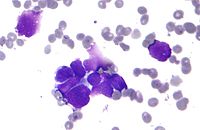
Photo from wikipedia
Squamous cell carcinoma is the main subtype of esophageal cancer in East Asia. The effect of the number of lymph nodes (LNs) removed to treat middle and lower thoracic esophageal… Click to show full abstract
Squamous cell carcinoma is the main subtype of esophageal cancer in East Asia. The effect of the number of lymph nodes (LNs) removed to treat middle and lower thoracic esophageal squamous cell carcinoma (ESCC) in China remains controversial. Therefore, the present study aimed to investigate the impact of the number of LNs removed during lymphadenectomy on the survival of patients with middle and lower thoracic ESCC. Data were obtained from the Sichuan Cancer Hospital and Institute Esophageal Cancer Case Management Database from January 2010 to April 2020. Either three-field systematic lymphadenectomy (3F group) or two-field systematic lymphadenectomy (2F group) was performed for ESCC cases with or without suspicious tumor-positive cervical LNs, respectively. Subgroups were designed for further analysis based on the quartile number of resected LNs. After 50.7 months of median follow-up, 1,659 patients who underwent esophagectomy were enrolled. The median overall survival (OS) of the 2F and 3F groups was 50.0 months and 58.5 months, respectively. The OS rates at 1, 3 and 5 years were 86, 57 and 47%, respectively, in the 2F group, and 83, 52 and 47%, respectively, in the 3F group (P=0.732). The average OS of the 3F B and D groups was 57.7 months and 30.2 months, respectively (P=0.006). In the 2F group, the OS between subgroups was not significantly different. In conclusion, resection of >15 LNs during two-field dissection in patients with ESCC undergoing esophagectomy did not affect their survival outcomes. In three-field lymphadenectomy, the extent of LNs removed could lead to different survival outcomes.
Journal Title: Oncology Letters
Year Published: 2023
Link to full text (if available)
Share on Social Media: Sign Up to like & get
recommendations!